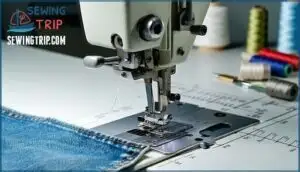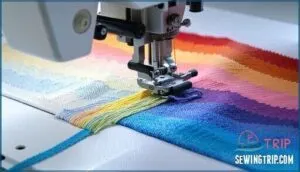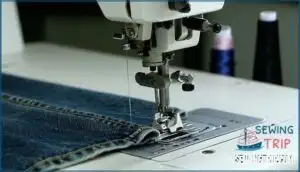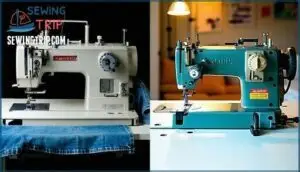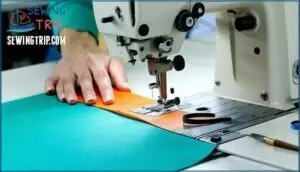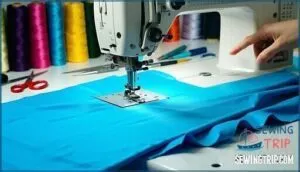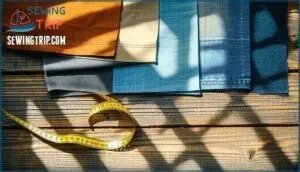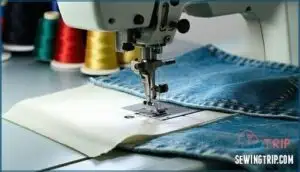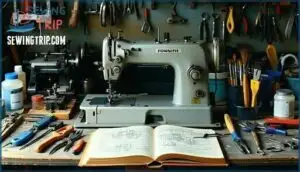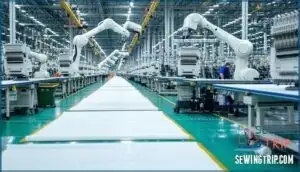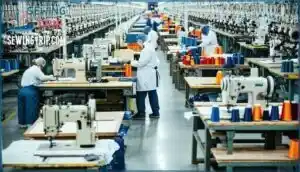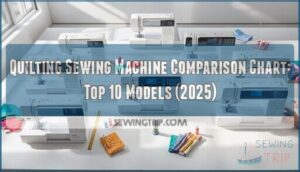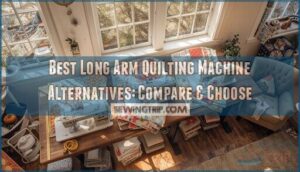This site is supported by our readers. We may earn a commission, at no cost to you, if you purchase through links.
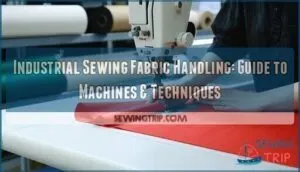 A single mishandled fabric layer can slow down an entire production line. Industrial sewing fabric management determines whether you produce 500 quality units per shift or spend hours fixing puckered seams and jammed machines.
A single mishandled fabric layer can slow down an entire production line. Industrial sewing fabric management determines whether you produce 500 quality units per shift or spend hours fixing puckered seams and jammed machines.
The difference between smooth operation and constant troubleshooting often comes down to understanding how fabric behaves at high speeds and how your machine reacts to different materials. From controlling thick leather through a walking foot to preventing stretch knits from distorting under the presser foot, proper fabric management keeps production moving and quality consistent.
This guide covers the machines, techniques, and practical know-how you need to manage fabric efficiently in an industrial setting.
Table Of Contents
- Key Takeaways
- What is Industrial Sewing Fabric Handling?
- Types of Industrial Sewing Machines
- Key Differences: Industrial Vs. Heavy-Duty Machines
- Essential Industrial Sewing Techniques
- Best Practices for Fabric Handling
- Choosing Fabrics for Industrial Sewing
- Industrial Sewing Machine Operation Guide
- Maintenance and Troubleshooting Tips
- Efficiency, Safety, and Sustainability in Sewing
- Industrial Sewing Applications and Market Trends
- Frequently Asked Questions (FAQs)
- Conclusion
Key Takeaways
- Industrial sewing fabric management determines production efficiency by controlling how materials move through high-speed equipment, affecting whether you produce quality units smoothly or spend hours fixing puckered seams and machine jams.
- Proper fabric handling requires matching machine type to material (lockstitch for general work, overlock for stretch fabrics, heavy-duty for thick materials), adjusting tension and presser foot pressure, and using techniques like walking feet to prevent slippage during production.
- Regular maintenance prevents most breakdowns—daily lubrication, needle replacement, bobbin area cleaning, and tension checks keep industrial machines running, while knowing when to call professionals for timing errors or motor failure saves costly downtime.
- Fabric selection impacts durability and performance, with polyester dominating industrial applications at 66% market share for toughness, cotton offering breathability for comfort-focused products, and synthetics like aramid or vinyl providing specialized properties like heat resistance or weatherproofing.
What is Industrial Sewing Fabric Handling?
Industrial sewing fabric management is the backbone of manufacturing work that puts materials through machines at speed and scale. It covers everything from how you feed fabric into industrial equipment to the techniques that keep production moving without snags or mistakes.
Let’s break down what this process involves, why it matters, and where you’ll see it in action.
Definition and Importance
Mastering industrial fabric management is the bridge between raw material and finished product, turning yards of potential into everything from safety gear to sailboat canvases.
Defining fabric management in the industrial context means controlling textile production processes through specialized sewing techniques and machinery. This skill is essential because proper management importance directly affects product quality and production speed.
Your understanding of fabric types and industrial sewing methods determines whether you’re manufacturing durable chair cushions or precision hazmat suits efficiently.
Key Processes Involved
Once you know what fabric management really means, the next step is understanding the hands-on processes that make your machine turn material into a finished product.
Material preparation starts your workflow, followed by cutting techniques that size your pieces accurately. Seam construction joins fabric layers through proper fabric control and industrial sewing machines.
Quality control catches defects during textile production processes, while finishing touches complete garment manufacturing processes using specialized fabric sewing methods.
Common Industrial Applications
After preparing and cutting your materials, you’ll see industrial sewing machines tackle real-world production.
Garment production dominates the field, accounting for over 40% of industrial sewing worldwide. Automotive textiles cover seat upholstery and interior trim in vehicles. Technical fabrics appear in protective clothing, construction tarps, and safety equipment. Furniture upholstery construction uses specialized products like flame-resistant materials.
These industrial sewing machines accommodate everything from garment manufacturing to textile production for mining and heavy industry applications. The market is expected to see significant market growth by 2030.
Types of Industrial Sewing Machines
When you’re ready to step into industrial sewing, you’ll find that not all machines are built the same. Each type fulfills a specific purpose and works with fabric in its own way.
Let’s look at the main categories you’ll encounter in manufacturing and production settings.
Lockstitch Machines
If you’ve ever wondered how factories keep churning out thousands of perfect seams without missing a beat, lockstitch machines are the workhorses behind it all. They use a top and bottom thread to form each stitch, creating strong seams that won’t unravel. Here’s what makes them essential for fabric work:
- Stitch formation creates interlocking loops that hold materials securely
- Needle feed systems help control tricky fabrics by feeding from multiple points
- Tension balance between threads guarantees consistent, professional results
These industrial sewing machines process everything from lightweight garments to heavy canvas, making them the go-to choice for most sewing applications.
Overlock and Coverstitch Machines
When you’re sewing stretchy fabrics or finishing edges that need to look professional, overlock and coverstitch machines step in where lockstitch machines leave off. Overlock machines, also called sergers, trim and seal seams in one pass, preventing fraying on knits. Coverstitch machines create stretchy hems perfect for activewear.
Differential feed controls fabric layers, while flatlock seams and rolled hemming give you clean finishes. Chain stitching locks everything securely for durable fabric manipulation in industrial sewing applications.
Heavy-Duty and Automatic Machines
Thick canvas, heavy denim, and high-speed production lines demand machines built to manage what standard equipment simply can’t. Heavy-duty sewing machines power through multiple layers of tough materials, while automated sewing systems boost production speed with programmable sewing patterns.
These specialized applications rely on automated stitching for fabric control precision. That’s why manufacturers choose industrial sewing machines designed for heavy-duty materials over standard models when consistency matters.
Key Differences: Industrial Vs. Heavy-Duty Machines
If you’re wondering whether an industrial machine is really worth the investment over a heavy-duty home model, the answer lies in how each one approaches speed, setup, and long-term use.
Industrial machines aren’t just bigger versions of what you’d find at home—they’re built from the ground up for different demands. Let’s break down what sets them apart in three key areas.
Stitch Count and Speed
The biggest difference you’ll notice between industrial and heavy-duty machines isn’t just power—it’s how fast they can stitch and how many stitches they can process per minute. Industrial machines can reach speeds of 5,000 stitches per minute or more, while heavy-duty models usually max out around 1,100 SPM. This speed control lets you adjust fabric feed rates for different materials, giving you better stitch density and regulation when you need it most.
| Machine Type | Stitches Per Minute | Best Use |
|---|---|---|
| Industrial Sewing Machine | 3,000–5,000+ SPM | High-volume production |
| Heavy-Duty Machine | 800–1,100 SPM | Home or small projects |
| Speed Sweet Spot | 2,500–3,500 SPM | Precision industrial sewing techniques |
Motor Types and Table Setup
Your machine’s motor and table setup work like a pair—one drives the action, the other holds everything steady. Servo motors offer quiet operation and precise motor control through the foot pedal, while clutch motors run louder but cost less upfront. Industrial sewing machines mount motors underneath sturdy tables for vibration reduction and table ergonomics, unlike home models.
| Motor Type | Key Features |
|---|---|
| Servo Motors | Silent, energy-efficient, automatic thread cutters, better motor control |
| Clutch Motors | Louder operation, higher vibration, requires more motor maintenance |
Cost and Maintenance Requirements
Budgeting for an industrial machine means planning beyond the price tag, because maintenance costs can add up faster than you might expect. Industrial sewing machine maintenance requires regular part replacement and preventative maintenance to avoid downtime costs that can halt production. Heavy-duty machines cost less upfront but won’t match the machine lifespan of industrial equipment.
| Cost Factor | What to Expect |
|---|---|
| Initial Purchase | Industrial machines: $2,000–$10,000+; Heavy-duty: $500–$2,000 |
| Routine Maintenance | Oil changes, cleaning, tension checks every 40–80 hours |
| Repair Costs | Professional service: $75–$200/hour plus parts |
| Part Replacement | Needles, bobbins, belts wear faster under constant use |
| Downtime Impact | Lost production can exceed repair costs in high-volume shops |
Essential Industrial Sewing Techniques
Getting your industrial machine ready to sew starts with three foundational steps that you’ll use on every project. Threading the machine correctly sets the stage for smooth operation, while proper tension and stitch adjustments make sure your seams come out just right.
Let’s walk through each technique so you can start sewing with confidence.
Threading and Tension Adjustment
Threading your machine correctly is like tuning a guitar—get it wrong and everything sounds off. Follow these threading techniques carefully:
- Wind your bobbin evenly for smooth thread delivery
- Guide thread through each tension disk and guide
- Check that your needle is threaded front to back
Test your balanced stitches on scrap fabric. If you see loops or puckers, tension troubleshooting starts with thread quality and proper threading systems before adjusting dials.
Setting Stitch Length and Width
Once you’ve nailed the threading, dialing in the right stitch length and width puts you in the driver’s seat for clean, professional seams. Your stitch regulation dial controls stitch length impact—shorter for heavy fabrics, longer for lightweight materials.
Width adjustment uses matter most on zigzag and decorative stitch settings. Fabric thickness effect requires tension balance tweaks.
Industrial sewing machine features like adjustable stitch length give you precise control over every sewing technique.
Using The Reverse Lever
Knowing how to backstitch keeps your seams from unraveling right when you need them most. The reverse lever on your industrial sewing machine lets you lock stitches at the start and end of each seam.
Press the lever down while sewing to create a back tack that reinforces fabric security. This simple sewing technique prevents unraveling and gives you professional-grade seam reinforcement every time.
Best Practices for Fabric Handling
Working with fabric on an industrial machine takes more than just good technique. Small adjustments in how you guide material and prep your workspace can prevent common headaches like crooked seams or sticky needles.
Here are three practices that will keep your fabric moving smoothly and your stitches straight.
Straight Line Sewing Tips
Keeping your fabric moving in a straight line takes more than just following the edge of your presser foot. You need consistent seam allowance by aligning fabric edges with markings on your industrial sewing machine’s throat plate.
Adjust presser foot pressure so material feeds smoothly without fabric drift.
Control sewing speed and maintain stitch length consistency when guiding fabric straight through lockstitch operations.
Preventing Needle Gumming With Basting Tape
Basting tape can save you time during assembly work, but it leaves behind sticky residue that clogs your needle and gums up your machine if you don’t watch where you stitch. Here’s how to keep your industrial sewing machine running smoothly:
- Place tape outside your seam allowance so the needle never touches adhesive during fabric manipulation
- Clean your needle with rubbing alcohol when you notice thread tension issues or skipped stitches
- Switch to wonder clips or pins as tape alternatives for material compatibility with delicate fabrics
- Test tape application on scrap pieces before your actual project to understand gumming causes
- Keep sewing techniques consistent by positioning basting tape at least half an inch from your stitch line
Managing Tricky Materials
When slippery synthetics slide around or stretchy knits refuse to cooperate, you’ll need more than basic sewing skills to keep your seams straight and your tension even. Needle selection matters when working with vinyl fabric or leather sewing projects.
Match your needle to the material weight, adjust tension control for seam puckering prevention, and use a walking foot for preventing slippage on marine canvas and other heavy-duty sewing techniques requiring sophisticated material feed systems.
Choosing Fabrics for Industrial Sewing
Picking the right fabric makes all the difference when you’re working with industrial machines. The material you choose affects how smooth your project runs and how long the finished product lasts.
Let’s look at the main things you need to think about when selecting fabrics for industrial sewing.
Fabric Types and Their Uses
Choosing fabric types is like picking the right tool for the job—you need to match material properties to your project demands. Here are three major categories you’ll encounter:
- Polyester Durability – Dominates industrial markets with over 66% market share due to resistance to stretching and quick-drying properties. You’ll find it in automotive upholstery fabric, conveyor belting, and marine canvas applications where toughness matters.
- Cotton Comfort – Offers breathability and enhanced seam efficiency (up to 53%) for protective clothing, uniforms, and medium-duty workwear. Its natural absorbency makes it ideal when comfort meets functionality.
- Synthetic Applications – Spandex adds stretch for performance wear, while aramid fibers provide heat resistance. Fiberglass and vinyl fabric excel in filtration and weather-resistant technical textiles. Sunbrella fabric falls into this category for outdoor durability. The market is experiencing sustainable growth, driven by eco-friendly initiatives.
Double Rub Rating Explained
How do you know a fabric is tough enough for high-traffic seating or marine canvas? That’s where double rub rating—your abrasion resistance standard—steps in. Wyzenbeek vs Martindale tests measure it, guiding you in choosing upholstery fabric that meets durability classifications, fabric longevity, and regulatory compliance.
Here’s a quick-glance chart for everyday reference:
| Durability Class | Double Rubs (Wyzenbeek) |
|---|---|
| Delicate Duty | <3,000 |
| Light Duty | 3,000–9,000 |
| Medium Duty | 9,000–15,000 |
| Heavy Duty | 15,000–30,000 |
| Extra-Heavy Duty | 30,000+ |
Cleaning and Care Considerations
Your fabric might survive the double rub test, but without proper cleaning and care, it won’t last through the first month of real-world use. Check manufacturer labels for wash cycles and heat limits before you sew. Some industrial fabrics tolerate bleach while others need gentle cleaners.
Pre-wash material when possible to avoid surprises like shrinkage or color bleeding later on.
Industrial Sewing Machine Operation Guide
Getting your industrial sewing machine up and running doesn’t have to feel like learning a foreign language. The key is understanding the basics before you fire up that motor for the first time.
Let’s walk through what you need to know to operate your machine safely and confidently.
Step-by-Step Usage Instructions
Setting up an industrial sewing machine for the first time might feel like preparing for liftoff, but once you know the sequence, each step clicks into place with satisfying precision. Start by threading the machine following your threading guide, then adjust tension control for balanced stitches. Set your stitch settings according to fabric weight.
Practice reverse sewing to lock seams, and always test on scrap material before working with production fabric.
Safety Precautions and User Manuals
Industrial machines can stitch through layers of canvas without breaking a sweat, but they can also stitch through your finger just as easily if you’re not careful. Always read your user manual before operating any industrial equipment.
Keep your workspace clean and locate the emergency shut-off switch before starting. Wear appropriate PPE and never bypass safety guards.
Routine inspections catch problems early, making machine maintenance tips your best defense against accidents during sewing machine operation.
Recommended Machines for Beginners
Once you know the safety rules, the next question is which machine won’t leave you frustrated on day one. Start with a reliable lockstitch model that balances machine ease with a manageable learning curve:
- JUKI DDL-8700 – Commercial sewing machine with maintenance simplicity
- Consew 206RB-5 – Budget option for heavy materials
- Singer 191D-30 – Straightforward feature prioritization
- Reliable MSK-8420B – Beginner-friendly industrial sewing machine
- Brother S-7250A – Lower cost with solid performance
Choose based on your fabric needs and budget.
Maintenance and Troubleshooting Tips
Keeping your industrial sewing machine in good working order doesn’t have to feel like guesswork. Regular upkeep prevents most problems before they start, and knowing how to spot common issues saves you time and frustration.
Let’s walk through the essential maintenance tasks, typical troubleshooting scenarios, and when it’s time to call in an expert.
Routine Maintenance Checklist
A well-maintained machine won’t let you down when you’re racing against a deadline, but skipping regular care is like asking for trouble halfway through a job.
Daily lubrication keeps parts moving smoothly, while needle replacement prevents snags and skipped stitches.
Clean the bobbin area regularly to avoid lint buildup, check belt tension for consistent speed, and inspect the motor for unusual sounds during Industrial Sewing Machine Operation.
Common Issues and Solutions
Even with regular care, machines still throw curveballs—thread bunching, skipped stitches, and tension headaches can stop your work cold if you don’t know what’s causing them. Here’s how to tackle the most common problems in Sewing Machine Troubleshooting:
- Thread Breakage – Check your tension settings and rethread the Industrial Sewing Machine completely.
- Skipped Stitches – Replace dull needles and verify correct needle size for your fabric weight.
- Fabric Slippage – Adjust presser foot pressure and use appropriate feed dogs for Fabric Control and Feeding.
- Uneven Seams – Clean the bobbin case and make certain balanced tension on both threads.
- Needle Snapping – Slow down on thick materials and confirm the needle isn’t bent or installed incorrectly.
When to Seek Professional Repairs
Some problems look simple on the surface but hide bigger mechanical issues that need a trained technician to fix safely and correctly. If you hear unusual noises like grinding or knocking, or face complex issues such as timing errors or motor failure, don’t risk downtime costs by guessing—call a pro for part replacements and preventative maintenance to keep your industrial sewing machine running smoothly.
| Problem Sign | When to Call a Professional |
|---|---|
| Grinding or knocking sounds | Indicates internal timing or gear damage |
| Motor won’t start or overheats | Electrical or motor failure requiring expert diagnosis |
| Timing errors or looping stitches | Needs precise hook-and-needle calibration |
| Oil leaks or bearing wobble | Internal component wear beyond basic maintenance |
| Persistent tension problems after adjustments | May involve bobbin case or tension assembly replacement |
Efficiency, Safety, and Sustainability in Sewing
Running an industrial sewing operation means balancing speed with smart practices that protect both your workers and your bottom line. You can’t ignore the connection between productivity, safety, and resource use if you want a shop that runs smoothly for the long haul.
Let’s look at three areas where small changes make a big difference in how your operation performs.
Automation and Productivity Improvements
Automation has transformed industrial sewing into a powerhouse of efficiency. Robotics adoption remains modest at 2.1% in textile manufacturing, but automated sewing machines have slashed production time by roughly 50% for routine tasks. Industry 4.0 technologies like IoT sensors and predictive maintenance reduce downtime while improving workflow.
Motor control and automation enable precise stitch uniformity, cutting defect rates by up to 30%. Manufacturing equipment now manages higher volumes faster, and the automation-enabled market is projected to hit $8.5 billion by 2033, proving smart industrial machines deliver real labor reduction and quality control gains.
Ergonomics and Injury Prevention
Poor setup at sewing workstations drives widespread pain and lost productivity. Research shows 88% of operators report lower back pain, and over 58% of workstations fail ergonomic standards. Workstation mismatch between operator dimensions and industrial equipment operation creates preventable musculoskeletal disorders.
- Chair Interventions with adjustable height and curved seat pans reduced monthly back pain scores by 0.43 points while improving correct posture
- Ergonomic Equipment like hydraulic tables cut muscle strain and injury factors through better alignment and vibration sensors
- Safety training lowered injury rates by 60%, while job stress and sleep disorders tripled injury risk
- Proper sewing safety precautions and compatible industrial equipment usage protect you during repetitive industrial sewing machine operation
Energy Efficiency and Waste Reduction
Energy used in sewing factories doesn’t just vanish—it shows up on your electricity bill and in your carbon footprint. Sewing machines account for approximately 70% of total energy consumption in apparel manufacturing. Motor efficiency improvements, like switching to direct-drive servo motors, can slash energy use by up to 50% compared to clutch motors.
Process innovation through waste segregation and textile recycling helps you reclaim up to 74.5% of pre-consumer fabric waste. Recycled fibers cut water consumption by 98% versus virgin cotton.
Regulatory compliance now demands traceability and disclosure, pushing industrial sewing best practices toward sustainable manufacturing processes. Fabric selection and care choices, combined with smart industrial equipment selection, directly impact both your operational costs and environmental responsibility.
Industrial Sewing Applications and Market Trends
Industrial sewing machines don’t just sit in factories—they’re building everything from safety gear to sailboats. The range of products these machines create might surprise you, and the market for them keeps expanding.
Let’s look at where industrial sewing shows up in the real world and what the numbers tell us about where it’s headed.
Garment and Upholstery Manufacturing
From the precision stitching on your favorite jeans to the plush cushions on your couch, industrial sewing machines are the workhorses behind nearly every piece of clothing and upholstered furniture you encounter daily.
In garment construction, these machines oversee pattern grading, seam construction, and quality control with speed and accuracy. Upholstery sewing demands durable fabric management and ergonomic design to manage thick materials.
Automation integration now streamlines production while maintaining the craftsmanship you expect.
Technical and Outdoor Fabrication
When a hazmat suit needs to hold up in a chemical spill or a mountaineering tent has to withstand alpine winds, you’re looking at the demanding technical and outdoor fabrication where mistakes aren’t just costly—they can be dangerous.
Industrial sewing machines use specialty fabrics like ripstop nylon and waterproof canvas, creating load-bearing seams with precise pattern design.
Whether it’s marine canvas fabrication for sailboats or weatherproofing techniques for backpacking gear, seam reinforcement becomes non-negotiable when lives depend on your stitches holding strong.
Global Market Growth and Statistics
The industrial sewing machines market is on a serious upswing—projections show growth from USD 6.5 billion in 2025 to USD 9.3 billion by 2035, with a market CAGR hovering around 5-6%. Asia-Pacific commands 43% of regional shares, while automation impact drives efficiency gains in textile manufacturing processes.
Key drivers include automotive upholstery demand and Industry 4.0 adoption, reshaping future projections for textile production techniques across manufacturing process improvements.
Frequently Asked Questions (FAQs)
How do you prevent fabric slipping during sewing?
To prevent fabric from slipping, adjust your presser foot pressure to match the material’s weight. Use a walking foot for tricky fabrics, as it feeds from both top and bottom.
Clean feed dogs guarantee proper grip and movement through the machine.
What needle sizes work best for different fabrics?
Choosing your needle is like matching the right tool to the job—get it wrong, and you’ll fight every stitch. Thread compatibility and fabric thickness impact your results directly.
You need size 9-11 for lightweight fabrics, 14-16 for medium-weight materials, and 18-23 for heavy-duty projects like canvas or leather.
How do you handle fabric puckering issues?
Puckering often happens when tension is too tight or your presser foot pressure is off. Check your tension adjustment first and lighten the presser foot if needed.
Make sure you’re using the right needle type for your fabric, and let the feed dog move the material without pulling it yourself.
What threading patterns suit specific industrial applications?
You’ll find that different materials demand unique approaches. Heavy canvas needs a sturdy Z-pattern thread weave for maximum thread pattern strength, while delicate synthetics work best with straight-line threading to prevent snags and preserve fabric feel.
How do you store large fabric rolls efficiently?
Store fabric rolls upright on vertical roll racks to save floor space and prevent damage. Label each roll for quick inventory management.
Keep heavy rolls at waist height to reduce strain during fabric manipulation.
Use climate-controlled areas to maintain fabric quality.
Conclusion
Every thread matters when you’re pushing thousands of units through production daily. Mastering industrial sewing fabric control isn’t about memorizing machine specs—it’s about reading how fabric moves under the presser foot and adjusting before problems compound.
You’ve learned the machines, techniques, and troubleshooting methods that separate efficient operators from those constantly fighting their equipment. Now you hold the framework that turns fabric management from guesswork into precision.
Apply these principles consistently, and your production line will run smoother than you thought possible.
- https://www.linkedin.com/pulse/industrial-fabric-sewing-machine-market-size-3kgmc
- https://straitsresearch.com/report/industrial-sewing-machine-market/north-america
- https://www.gminsights.com/industry-analysis/industrial-sewing-machine-market
- https://laccei.org/LACCEI2022-BocaRaton/full_papers/FP752.pdf
- https://onlinelibrary.wiley.com/doi/10.1155/2024/6697213

